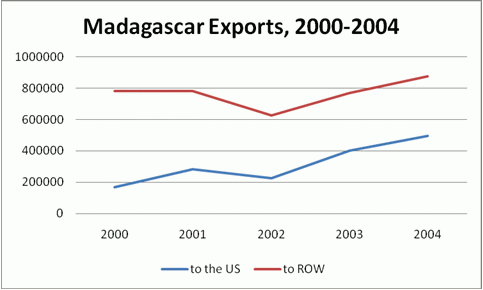When the US granted duty free/quota free access to Madagascar under the African Growth and Opportunity Act 2000, exports from Madagascar exploded, from $170 million in 2000 to $500 million in 2004. Over the same period, Madagascar’s export to the rest of the world also increased, from $750 million to $875 million (Figure 1). Similarly, when the EU granted duty free/quota free access to Bangladesh under the Everything But Arms Initiative in 2001, knitwear exports from Bangladesh to the EU more than doubled, from $1.3 billion in 2000 to $3 billion in 2004. During the same period of time, knitwear exports from Bangladesh to the US also increased by $30 million. Much to the surprise of many, such generous trade preferences resulted not in trade diversion from the rest of the world to the preference granting markets, but in trade creation to the rest of the world. What could explain this?
Figure 1. Madagascar exports, 2000-2004
Since time immemorial, countries have given foreign aid to those less fortunate. We economists have argued that “trade as aid” – granting preferential access to developing countries like Madagascar and Bangladesh – has several things to recommend it. It works with the market so that efficiency is rewarded. It is less likely to be subverted than the usual forms of development aid (for the evidence on various problems with the usual forms of developed aid see, for example, Birdsall 2008).
The way that trade preferences for developing countries have been seen has undergone a dramatic evolution over the years. Their early perception as nursemaids to infant industries then developed to their vilification as obstacles that prevent such industries from ever “growing up” reflects the move towards market oriented development (see Hoekman and Özden 2005 for a survey). In recent research (Cherkashin et al. 2010), however, we argue that giving preferences can result in a win-win scenario for the parties concerned. Moreover, the effects of such preferences can be very large.
Our model of trade preferences
These insights come from counterfactual simulations on an estimated model of monopolistic competition with heterogeneous firms who face firm and market specific demand shocks, but are subject to fixed costs of various sorts in their attempts to access world markets. We are careful to model aspects of trade preferences like Rules of Origin that are a critical part of the operation of such preferences. As firms face different trade rules in various export destinations, they have a choice of serving the foreign market under the tariff, or obtaining the preferences and selling there at zero tariff rates. The latter choice comes with a price as it involves documentation costs as well as the use of more expensive domestic inputs due to the presence of restrictive Rules of Origin.
We confront the model with a representative firm level data set and actual trade policies in the case of Bangladeshi garment exports into the US and EU markets and estimate all of its structural parameters, including the various levels of fixed costs. These fixed costs are at the core of the models and serve as hurdles that productive/fortunate firms choose to jump, while those that are less so do not. One of the advantages of our approach to estimating the structural parameters is that it uses only cross sectional data to recover all the structural parameters of the model, including fixed costs at different levels. Such cross-sectional data is commonly available, which makes our procedure widely applicable in contrasts to the structural dynamic approach taken in recent work, which is limited to where data is available over a period of time.
The fixed costs we estimate include entry costs at the industry and market levels (estimated at approximately $1,500,000 and $53,000-$72,000, respectively) as well as fixed costs of production and documentation costs needed to obtain preferences (estimated at approximately $35,000 and $72,000, respectively). Moreover, all our estimates seem reasonable and roughly in line with previous work. We then use the estimated model to evaluate the costs of the different kinds of trade polices used in practice.
We find that the developed country giving preferences (the EU) gains from these preferences. Though it loses some tariff revenues, these are outweighed by consumer surplus gains from lower prices. These lower prices come about from entry into exporting in the developing country. These preferences raise the profits of potential exporters in the affected developing country, and hence induce entry and greater exports to the EU. But contrary to what happens in competitive markets, where exports are diverted away from other markets, like the US, exports from Bangladesh to all markets rise.
Why? The increased profitability leads to greater entry as more firms enter in the developing country, Bangladesh. Once they enter, they export to all markets, not just the EU. As a result, prices facing consumers in the US and EU fall and both countries gain. In addition, the developing country gets to increase its exports, earning foreign exchange and employing its labour force. Our simulations suggest that these effects are large. We also find that reducing fixed costs at all levels has a catalytic effect on exports. A reduction of fixed costs of all exporters of $1 results in a $10-$40 increase in exports. The effect is at the lower end when other potential markets are quota ridden.
Policy implications
Our results have some implications for developing and transition countries. Corruption and bureaucracy raise fixed and marginal costs faced by firms. Our work suggests that even small increases in such costs can result in huge reductions in entry, production, and exports of a country. Conversely, reining in such costs can do much good. Our work can also be seen as highlighting the importance of other initiatives that reduce search costs or inherent uncertainties in the market. Thus, export fairs, tribunals for dealing with complaints about product quality, and other policies that reduce the costs of doing business in developing countries may have unexpectedly large effects.
Finally, exporting countries that do not get preferences will suffer. For this reason it is important to target such preferences to the most needy. So for the case of Madagascar and Bangladesh, generous trade preferences given by the US and the EU, respectively, may have encouraged tremendous entry of firms, which, in addition to exporting to the preference granting markets, also exported to the rest of the world, generating a win-win-win situation.
References
Birdsall, N (2008), “Seven Deadly Sins: Reflection on Donor Failings,” in William Easterly (ed.), Reinventing Foreign Aid, MIT Press.
Cherkashin, I, S. Demidova, H.L. Kee, K. Krishna (2010) “Firm Heterogeneity and Costly Trade: A New Estimation Strategy and Policy Experiments,” NBER working paper 1655
Hoekman, B and C Özden (2005), “Trade Preferences and Differential Treatment of Developing Countries: A Selective Survey”, World Bank Policy Research Working Paper 3566.






